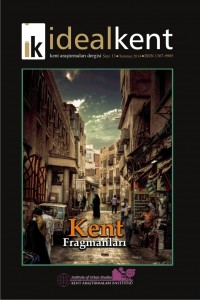Abstract
Küresel
kalkınma politikaları ve kentsel dönüşüm yatırımlarının güncel tartışma konuları
olup, büyük toplumsal hareketleri tetiklediği günümüz siyaset ortamında, sözü
geçen çatışmaların merkezinde, yerel ve merkezi yönetim birimleri, STK'lar ve
mimarlar yer almaktadır Şehrin sermaye veya mülk sahibi olmayan
kullanıcılarının kent üzerinde söz sahibi olmasına engel olan bu organizasyon
karşısında mimarların kent hakkını savunucu rol ve sorumluluklarının mimarlık
eğitimine nasıl aktarılabileceği bu araştırmanın odak noktasını
oluşturmaktadır. Katı yönetim organlarının himayesinde yürütülen inşa
faaliyetleri kapsamında hiçe sayılan “kent hakkı”nın savunucusu mimarlar
olabilir mi? Peki kent hakkı ve mimarın üstleneceği toplumsal roller mimarlık
eğitimi süreçlerinin hangi aşamasında ve nasıl dahil edilebilirler?
Bu
bağlamda İKÜ, Mimarlık Fakültesi, 5.yy Mimari Tasarım Stüdyosu kapsamında
“Mimarlık ve Siyaset” teması konu başlığı olarak seçilmiştir. Öğrenciler 14
haftalık süreç boyunca Karaköy'de çeşitli aşamaları kapsayan 3 atölye
çalışmasının ardından konusunu, alanını ve programını kendilerinin belirledikleri
tasarımlarını gerçekleştirmiş, kentsel ayrışma, dönüşüm, politika, siyaset,
rant ve kent hakkı vb. gibi kavramlar ile yüzleşmiş ve gerçek hayatta uygulamaya
yönelik karşılarına çıkabilecek engellere gösterecekleri mimarca tepkilerin
neler olabileceğine yönelik çözümler üretmişlerdir.
References
- Cox, K.R. (1989), “Urban Growth Machines and the Politics of Local Economic Development”, Book Review Essay of Logan, J.R. and Molotch, H.L. 1987: Urban fortunes: the political economy of place, Berkeley and Los Angeles, University of California Press, IJURR, cilt: 13, no: 1, March.
- Dündar, Ö., Tekel, A. (1996), “Kent Mekanını Kimler Biçimlendirmeli? Aktörler ve İdeolojiler mi, Halk mı, Yoksa....), İdeoloji, Erk ve Mimarlık Sempozyumu, Bildiri Kitabı, Egemen Print, İzmir, 11-13 Nisan, s.109-114.
- Gottdiener, M., (1993), “A Marx for our Time: Henri Lefebvre and the Production of Space”, Sociological Theory, cilt 11, sayı:1, 1993, s.132-133.
- Harvey, D.,(2013), “Asi Şehirler”, Metis Yayınları, İstanbul.
- Jameson, F. (1998), “Mekan Politik midir?”, Any Seçmeler, Rana Nergis Öğüt (Çev.), Mimarlar Derneği Yayınları, Ankara, s. 108-121.
- Lefebvre, H. (1991), “The Production of Space”, Blackwell Publishers, Oxford, 1991, s.11.
- Popper, K., (1998), “Tarihselciliğin Sefaleti”, çev. Orman, S., İnsan Yayınları, İstanbul.
- Park, R. (1967), On Social Control and Collective Behavior, Şikago, s. 3.
- Tanyeli, U. (2011), “Rüya, İnşa İtiraz”, Mimarlık Okulları Uygulama Öğretebilir mi?, Boyut Yayın Grubu, İstanbul, s.211-215.
Abstract
Todays political environment activating huge global
development policies and urban renewal projects is cousing battle royals
triggering massive social responses in country-wide scales and central government
units, non-governmental organizations and architects are centered in the heart
of these discussions. This iniquitous situation puts the architects in a
critical position; what are the responsibilities of an architect to the
community? In a capital dominated society, can the architect be advocate of
‘right to the city’? If yes, how and specifically when this social roles and
responsibilities can be included in architectural education?
In this context, 5th semester Architectural Design
Studio in Istanbul Kultur University is selected as a case and ‘Architecture
and Politics’ has given to the students as the theme for the project. The target of the studio was to
create a consciousness regarding the efficient role of architects and the
students were expected to complete the project design processes working on the
concept of ‘advocating the right to the city’. This study is important, from
the point of bringing a new approach to the political issues -which is a part
of everyday life, parallel to their approach to the design problems handled in
the architectural design education.
References
- Cox, K.R. (1989), “Urban Growth Machines and the Politics of Local Economic Development”, Book Review Essay of Logan, J.R. and Molotch, H.L. 1987: Urban fortunes: the political economy of place, Berkeley and Los Angeles, University of California Press, IJURR, cilt: 13, no: 1, March.
- Dündar, Ö., Tekel, A. (1996), “Kent Mekanını Kimler Biçimlendirmeli? Aktörler ve İdeolojiler mi, Halk mı, Yoksa....), İdeoloji, Erk ve Mimarlık Sempozyumu, Bildiri Kitabı, Egemen Print, İzmir, 11-13 Nisan, s.109-114.
- Gottdiener, M., (1993), “A Marx for our Time: Henri Lefebvre and the Production of Space”, Sociological Theory, cilt 11, sayı:1, 1993, s.132-133.
- Harvey, D.,(2013), “Asi Şehirler”, Metis Yayınları, İstanbul.
- Jameson, F. (1998), “Mekan Politik midir?”, Any Seçmeler, Rana Nergis Öğüt (Çev.), Mimarlar Derneği Yayınları, Ankara, s. 108-121.
- Lefebvre, H. (1991), “The Production of Space”, Blackwell Publishers, Oxford, 1991, s.11.
- Popper, K., (1998), “Tarihselciliğin Sefaleti”, çev. Orman, S., İnsan Yayınları, İstanbul.
- Park, R. (1967), On Social Control and Collective Behavior, Şikago, s. 3.
- Tanyeli, U. (2011), “Rüya, İnşa İtiraz”, Mimarlık Okulları Uygulama Öğretebilir mi?, Boyut Yayın Grubu, İstanbul, s.211-215.
Details
| Primary Language | Turkish |
|---|---|
| Journal Section | Articles |
| Authors | |
| Publication Date | July 31, 2014 |
| Published in Issue | Year 2014 Volume: 5 Issue: 13 |


